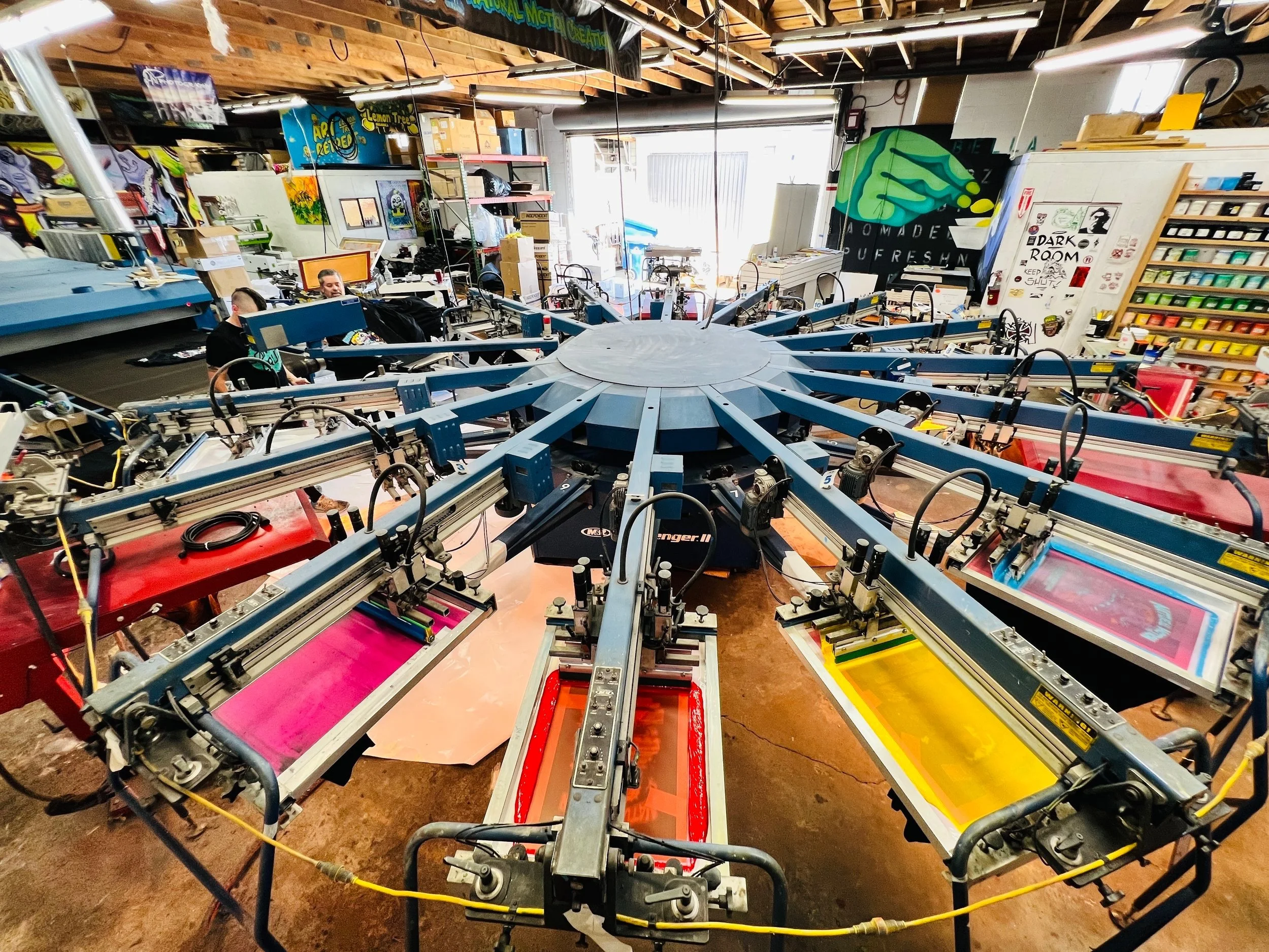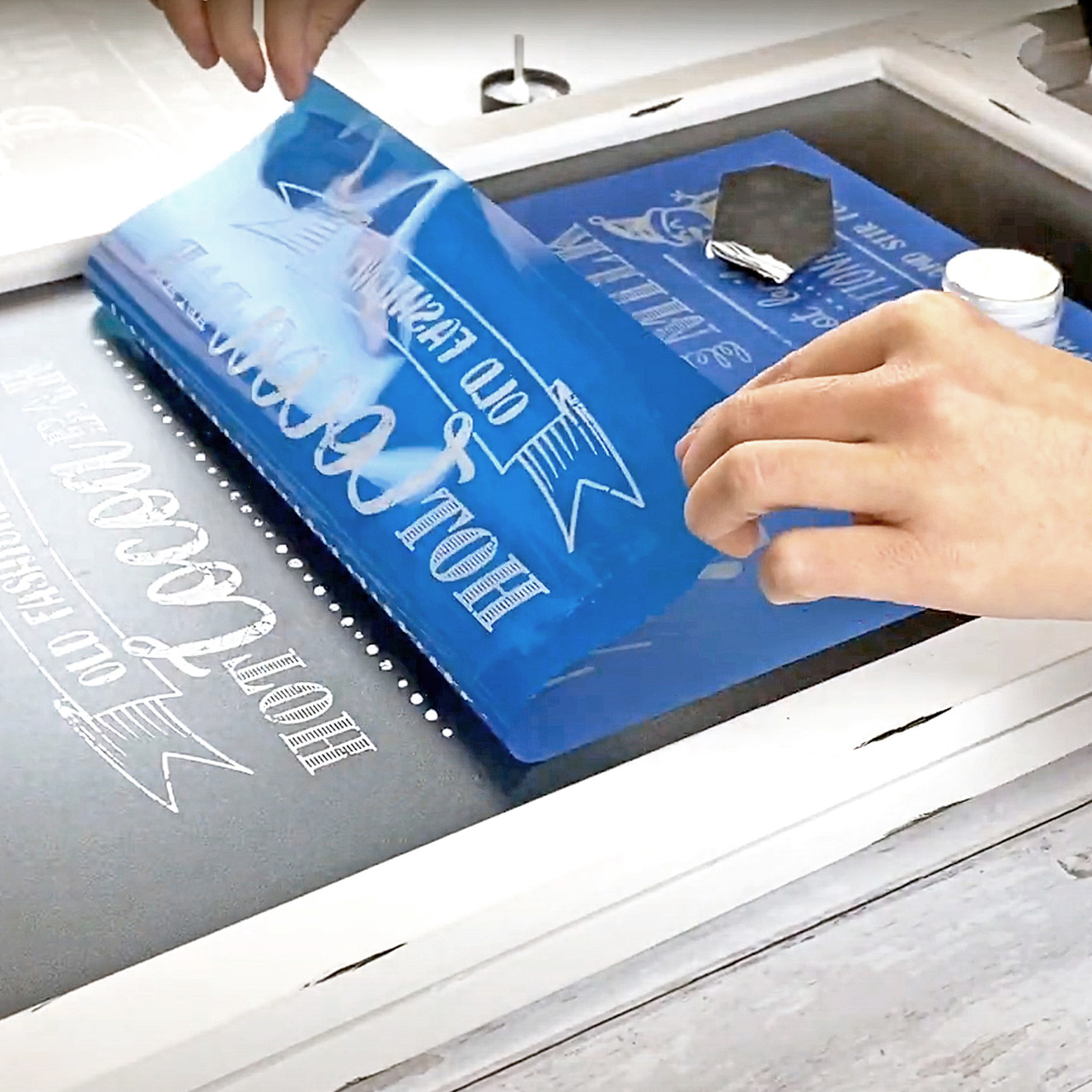Fast Turnaround Custom Screen Printing for Events
Wiki Article
Display Printing Uncovered: Everything You Required to Find Out About Tee Shirt and Garment Printing Methods
Display printing is a fascinating approach that combines art with strategy, providing countless possibilities for creativity. Ready to explore the crucial aspects that make display publishing an art form?
The Essentials of Display Printing: How It Works
When you dive right into display printing, you'll discover it's both a science and an art. At its core, display printing entails creating a stencil, or display, that enables ink to pass with only in details areas.Following, you'll blend your inks and prepare your printing surface. Placement the display over the material, then use a squeegee to push ink through the display onto the garment. This process requires precision, as you want clear, dynamic prints. After printing, you'll treat the ink with heat, guaranteeing it sticks to the textile and lasts through laundries. Each action is crucial, and grasping them will boost your display printing abilities, changing simple garments into distinct, meaningful items.
Kinds Of Screen Printing Techniques
Once you realize the fundamentals of display printing, it's time to explore the different strategies that can boost your designs. One popular technique is conventional display printing, where ink is pushed through a stenciled display. This strategy is great for vibrant, vivid shades. There's water-based ink printing, which offers a softer feeling and is environmentally friendly, yet it calls for a various approach to curing.If you're aiming for great details, take into consideration discharge printing. This technique removes dye from the material, leaving a soft, vintage appearance. An additional choice is plastisol printing, known for its sturdiness and vibrant colors, making it a favorite for many brands. Lastly, experiment with halftone printing to produce gradient effects and complex designs. Each technique has its distinct appeal, so don't hesitate to attempt them bent on locate what matches your design best!
Essential Tools for Screen Printing
To attain magnificent outcomes in display printing, having the right equipment is basic. You'll require a strong display printing framework, which holds the mesh that moves your design onto the garment. Next, invest in premium squeegees; these are essential for applying ink evenly across the screen.Picking the Right Inks and Materials
When choosing inks and products for display printing, you require to think about the kind of ink that functions finest for your task. Consider material compatibility to ensure your styles look last and wonderful lengthy. Check out eco-friendly ink options to make your printing procedure more lasting.Kinds of Screen Inks
Picking the ideal screen ink is crucial for achieving lively, resilient prints that fulfill your task's needs. There are numerous sorts of display inks to analyze. Plastisol ink is prominent for its convenience and ease of use, giving exceptional shade opacity on dark textiles. Water-based ink, on the various other hand, offers a softer feel and is green, making it excellent for those looking to reduce their ecological effect. Release inks eliminate color from the material, resulting in a soft, classic look yet call for details handling. Finally, specialty inks, such as metal or glow-in-the-dark, can include unique results to your designs. Assess your task requirements and pick the ink that lines up best with your preferred outcome.
Textile Compatibility Factors To Consider
Understanding textile compatibility is vital for accomplishing high-quality display prints, especially considering that different products react distinctly to various inks. Constantly test your inks on example textile to guarantee they stick appropriately and keep shade honesty. In addition, maintain in mind that material weight and structure can affect the final result, so selecting the appropriate ink and product combo is important for your job's success.Eco-Friendly Ink Options
Environmentally friendly inks are coming to be a prominent option for screen printers who intend to minimize their ecological influence while preserving high quality. When picking inks, consider water-based inks, which are less harmful and much easier to cleanse up contrasted to conventional solvents. These inks bond well with fabrics, delivering dynamic results without toxic chemicals. You may additionally check out eco-solvent inks that make use of fewer volatile organic compounds (VOCs), making them a much safer choice for both your health and wellness and the earth.Additionally, seek inks made from renewable energies, such as soy or vegetable-based choices. By selecting the best inks and materials, you'll not only produce spectacular designs yet additionally contribute to a much more lasting printing process. Make the button, and your prints will mirror your commitment to the atmosphere!
Preparing Your Design for Screen Printing

Submit Format Demands
To assure your style looks lively and sharp on textile, you'll require to pay close interest to submit style demands for screen printing. Make certain your style has a clear history to protect against undesirable white sides on your prints. Keep shade settings in mind; CMYK is conventional for screen printing, so transform your RGB makes as necessary.Color Splitting Up Strategies
Shade separation is an important action garment printing in preparing your layout for screen printing, and understanding it can substantially improve your print high quality. You'll need to damage your style right into specific colors, as each shade needs a different display throughout printing. This accuracy not just guarantees exact color representation however likewise enhances the printing procedure.Resolution and Size
Accomplishing the most effective outcomes in display printing starts with assuring your design has the ideal resolution and dimension. Preferably, your artwork should go to the very least 300 DPI (dots per inch) for sharp, clear prints. If you utilize reduced resolution, your final product may look pixelated and less than professional.When it pertains to dimension, think about the measurements of your print area. Design your art work to match the final print size, ideally producing it in the real measurements you'll be printing. By doing this, you'll stay clear of any kind of unexpected scaling issues.
Always check your design in both vector and raster layouts. Vector graphics can be scaled without shedding high quality, making them perfect for display printing. Preparing properly will ensure your layout looks outstanding on every garment!
Step-by-Step Display Printing Process
Screen printing is a vibrant procedure that enables you to produce dynamic styles on numerous surface areas. To get started, you'll require a display, solution, and your selected ink.After cleaning out the unexposed solution, your display is ready. Establish it up on your printing surface area and straighten your garment below it. Pour ink onto the display and utilize a squeegee to push the ink through the pattern onto the fabric. Lift the display very carefully and let the print dry. Lastly, treat the ink utilizing warm to guarantee toughness. That's it! You have actually efficiently screen published your layout.
Tips for Effective Screen Printing Projects
While you're diving into your display printing tasks, keep in mind that preparation is key to success. Begin by collecting all your materials-- inks, squeegees, displays, and garments. A clean work area helps prevent undesirable mistakes, so clean before you start.Following, verify your art work is high-resolution and properly sized for your garment. Examine your display for proper exposure and tidy it completely to prevent smudges. When blending your inks, comply with the manufacturer's guidelines to achieve the right consistency.
Throughout printing, use even stress with your squeegee for consistent outcomes. Do not rush; take your time to confirm each print meets your requirements. After printing, allow your garments completely dry totally prior to managing or packaging them.
Last but not least, constantly maintain a sample of your help future reference. In this manner, you can evaluate your progression and enhance your methods with time. Pleased printing!

Frequently Asked Inquiries
The length of time Does It Require To Establish a Screen Printing Job?
Establishing a screen printing job generally takes about 30 minutes to an hour. You'll prepare the screens, mix inks, and change journalism. The time differs based on complexity and experience, so stay organized!Can I Publish on Various Material Types Using the Exact Same Strategy?
Yes, you can publish on various textile types making use of the very same strategy, however you'll need to readjust your inks and setups. Some fabrics take in ink in different ways, so trying out guarantees the most effective results for each and every product.What Are Common Mistakes to Prevent in Screen Printing?
When display printing, stay clear of common blunders like using the wrong ink, neglecting appropriate direct exposure times, or skipping pre-press checks. Constantly evaluate your arrangement and maintain tidy displays to assure high quality results each time.Exactly How Can I Correctly Clean and Preserve My Display Printing Devices?
To correctly tidy and keep your screen printing tools, you should routinely wash screens with appropriate solvents, inspect mops for wear, and guarantee all tools are kept dry and dust-free. Uniformity protects against costly repair work and enhances efficiency.Is Screen Printing Environmentally Friendly Compared to Other Methods?
Display printing can be extra ecologically friendly than various other methods, specifically if you make use of water-based inks and eco-conscious materials. By selecting lasting supplies and techniques, you reduce waste and decrease your influence on the earth.Screen Printing Uncovered: Every Little Thing You Required to Know About Tee Shirt and Garment Printing Techniques
At its core, screen printing entails developing a pattern, or display, that enables ink to pass via only in specific areas. Setting the screen over the material, then use a squeegee to push ink with the display onto the garment. One preferred approach is typical display printing, where ink is pressed through a stenciled display.When picking inks and materials for screen printing, you require to take into account the kind of ink that functions ideal for your project.
Report this wiki page